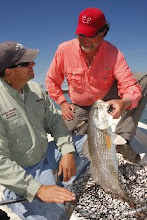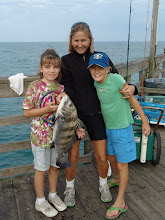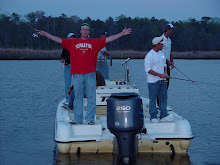CFRG Takes Position on Fisheries Issues
The following posts have been submitted by the CFRG to the appropriate people involved in the issues. The first deals with Spotted Sea Trout and attempts to change horses in the middle of the stream without new information on the stock status reports.
The second deals with shrimp. The DMF/MFC have opted to search for new By Catch Reduction Devices (BRD) for two years as their solution to the 24 million pounds of fish being killed annually in North Carolina inshore waters by shrimp trawlers harvesting a mere 5 million pounds of shrimp (average) per year.
January 14, 2014
Chip Collier 127 Cardinal Drive Wilmington, N.C. 28405 Chip.Collier@ncdenr.gov
Reference: Proposed Supplement SST FMP: Maintain short-term management measures to address stock assessment uncertainties
Mr. Collier:
The Coastal Fisheries Reform Group (CFRG) represents recreational coastal fishermen and supports science-based management of our marine fisheries. Within that purview we submit the following recommendation to continue present short-term management measures to govern speckled sea trout fishing activities until the ongoing stock assessment is complete. We think it would be premature to implement the planned restrictions scheduled to take effect in February, 2014. The stock assessment can be reviewed and long-term changes that may be necessary or desirable can be implemented later in 2014 or in 2015. We believe continuation of the short-term measures until the stock assessment can be analyzed is favorable to implementing the more restrictive measures now and then possibly changing them in just a few months.
To be specific, we support continuing the following regulatory regime for SST until the stock assessment is reviewed and other possible changes based upon the findings are proposed:
Maintain 14 inch minimum size limit, 75 fish daily creel limit, and weekend closure in joint waters (except Albemarle and Currituck Sounds) for commercial fishing and maintain 14 inch minimum size limit and 4 fish daily creel limit for recreational fishing.
Thank you for the opportunity to comment on this proposal.
January 16, 2014
Louis Daniel, Director Division of Marine Fisheries 3441 Arendell Street Morehead City, NC 28557
Dr. Daniel:
Reference: Proposed amendment Shrimp FMP to Reduce Bycatch
The Coastal Fisheries Reform Group (CFRG) is a coalition of recreational coastal fishermen, who support sound management of our marine fisheries based upon the best available science. We represent many thousands of fishermen from across the state who fish in our coastal waters. We have had over 127,000 hits on our blog site (http://cfrgnc.blogspot.com/) where we have discussed coastal fisheries issues since 2009. In the role as a voice for the average salt water fisherman, we submit the following comments on the proposed Shrimp FMP amendment to reduce finfish bycatch that the Marine Fisheries Commission will consider at their February 2014 meeting.
We strongly believe that the draft amendment to the shrimp plan, which includes only proposals for industry testing of bycatch reduction devices, updating testing protocols for the state bycatch reduction device certification program, and requiring additional bycatch reduction devices in all shrimp trawl nets, falls woefully short of an acceptable proposal to amend the Shrimp FMP to reduce bycatch.
The Shrimp FMP Advisory Committee met several times over the course almost a year and many additional, significant measures were discussed and considered. The proposals emerging from the study are almost meaningless and will do little if anything to reduce finfish bycatch in shrimp trawling operations. The recommended amendment contains no options for gear restrictions, no time closures, no areas closures, and no target reduction in bycatch. The Shrimp FMP should be amended to include goals, timetables, and management measures to accomplish significant by-catch reduction and an aggressive data collection and analysis program to monitor the success of management actions taken over the next five year period.
We quote here from the draft amendment (page 65 Section 6.3 Shrimp Trawl Bycatch):
“As perhaps the prime example of the new policy positions, the re-authorized Magnuson-Stevens Fishery Conservation and Management Act (MSFCMA) contains a National Standard (#9) requiring bycatch minimization (USDOC 1996). National Standard 9 states: “Conservation and management measures shall, to the extent practicable, (A) minimize bycatch and (B) to the extent bycatch cannot be avoided, minimize the mortality of such bycatch." Additionally, in 1991 the MFC adopted a policy directing the DMF to establish the goal of reducing bycatch losses to the absolute minimum and to consciously incorporate that goal into all of its, management considerations (Murrary et al. 1991).”
The CFRG urges the MFC to amend the Shrimp FMP to include the following provisions:
1. Limit all trawl nets in inshore coastal waters (especially Pamlico Sound) to a maximum headrope size of 110 feet and only allow two nets per boat. This would remove the large nets and their excessive bycatch but would allow the small trawlers that have shrimped in our sounds for generations to continue working uninterrupted. These smaller shrimp boats are mostly local boats, with local crews that sell their catch at local fish houses in North Carolina. Such a rule change would greatly benefit the vast majority of North Carolina shrimpers while truly helping our coastal economies and our marine resources by significantly reducing bycatch.
2. Limit tow times to 60 minutes. This would allow for some bycatch to be released alive and also increase the chance of sparing any endangered turtles which are entrapped in the net.
3. Delay shrimp season until the shrimp size has reached the level of having 36 to 41 (or lower) shrimp per pound. This would postpone the harvest of shrimp and allow juvenile finfish to grow larger and have more of a chance of escaping shrimp trawls. These fish would also have more time to move out of their nursery areas where the trawlers are now working. In addition, this change would cause the shrimp to be larger when they are harvested and market value would be greater, thereby benefiting shrimp fishermen.
4. Establish exclusion zones around both sides of our inlets where trawlers with headropes exceeding 110 feet would not be allowed. This would allow juvenile finfish that are transitioning to a life in the open ocean to escape our sounds without being killed by a shrimp trawler. These fish become concentrated when they are near the inlets and are especially vulnerable to trawlers until they can disperse into the ocean.
Now is the time to get serious about the finfish decimation caused by the current activities of shrimp trawlers in the inshore waters of NC. Destruction of fisheries resources of this magnitude cannot be tolerated any longer. If the proposed amendment to the Shrimp FMP is adopted as presented, the schedule for meaningful action will be delayed for years while we look for the magic solution that is right before us now. Establish some realistic goals, implement some meaningful management measures, set a timetable for implementation, evaluate improvements in terms of bycatch reduction, and make subsequent changes as dictated by results.


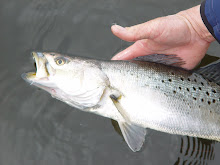



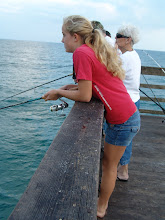

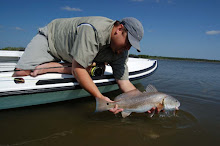.jpg)


